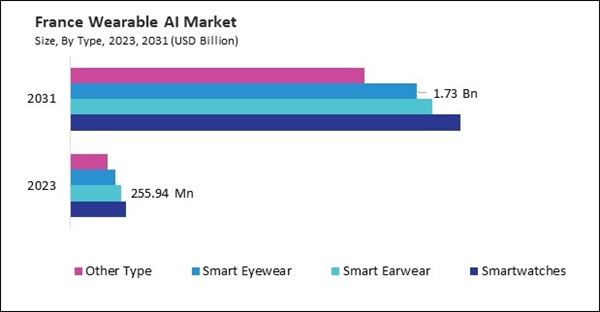The Germany market dominated the Europe Wearable AI Market by country in 2023, and is expected to continue to be a dominant market till 2031; thereby, achieving a market value of $11.68 billion by 2031. The UK market is exhibiting a CAGR of 26.9% during 2024-2031. Additionally, the France market is expected to experience a CAGR of 29.1% during 2024-2031.
The healthcare and fitness industries have emerged as some of the most prominent adopters of this technology, driving significant market momentum. Health-conscious consumers increasingly turn to wearables to monitor vital signs, track physical activity, and gain insights into their overall well-being. Moreover, the adoption of this extends far beyond personal health and fitness. Industries such as entertainment, retail, and education are leveraging the technology to enhance user experiences and operational efficiency.
The industrial sector has also recognized the potential of this AI to transform operations and improve safety. Devices such as smart helmets and wearable cameras equipped with AI capabilities are being deployed to monitor workplace conditions, track worker performance, and ensure compliance with safety protocols. In manufacturing and logistics, these devices facilitate hands-free communication, optimize workflows, and provide real-time feedback to enhance productivity.
Germany is a leader in integrating wearable AI in industrial applications, leveraging its strong manufacturing base. Trends like the Industrial Internet of Things (IIoT) and Industry 4.0 have accelerated the adoption of AI-powered wearables in sectors such as automotive and construction. Wearables like smart helmets and augmented reality glasses improve worker safety, enhance productivity, and optimize processes. France is emerging as a hub for innovative these solutions with a strong focus on sustainability. French startups are making strides in developing eco-friendly wearables, such as solar-powered smartwatches and biodegradable fitness trackers, reflecting the nation’s commitment to reducing its environmental footprint. The government supports this shift through policies like the Energy Transition for Green Growth Act, which encourages sustainable technological practices. Additionally, France is investing in wearable AI for healthcare, particularly in elder care, where devices like fall detection wearables and remote monitoring systems are being adopted to improve the quality of life for an aging population. Hence, these elements will aid in the expansion of the market.
List of Key Companies Profiled
- Apple, Inc.
- Sony Corporation
- Samsung Electronics Co., Ltd. (Samsung Group)
- Microsoft Corporation
- Garmin Ltd.
- Fitbit, Inc. (Google LLC)
- Huawei Technologies Co., Ltd. (Huawei Investment & Holding Co., Ltd.)
- Amazon Web Services, Inc. (Amazon.com, Inc.)
- IBM Corporation
- Oracle Corporation
Market Report Segmentation
By Operations
- On-device AI
- Cloud-based AI
By Type
- Smartwatches
- Smart Earwear
- Smart Eyewear
- Other Type
By Component
- Sensors
- Connectivity IC
- Processor
By Application
- Consumer Electronics
- Healthcare
- Automotive
- Military & Defense
- Media & Entertainment
- Other Application
By Country
- Germany
- UK
- France
- Russia
- Spain
- Italy
- Rest of Europe
Table of Contents
Companies Mentioned
- Apple, Inc.
- Sony Corporation
- Samsung Electronics Co., Ltd. (Samsung Group)
- Microsoft Corporation
- Garmin Ltd.
- Fitbit, Inc. (Google LLC)
- Huawei Technologies Co., Ltd. (Huawei Investment & Holding Co., Ltd.)
- Amazon Web Services, Inc. (Amazon.com, Inc.)
- IBM Corporation
- Oracle Corporation
Methodology

LOADING...









